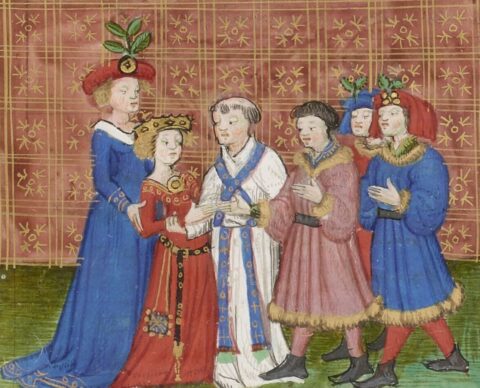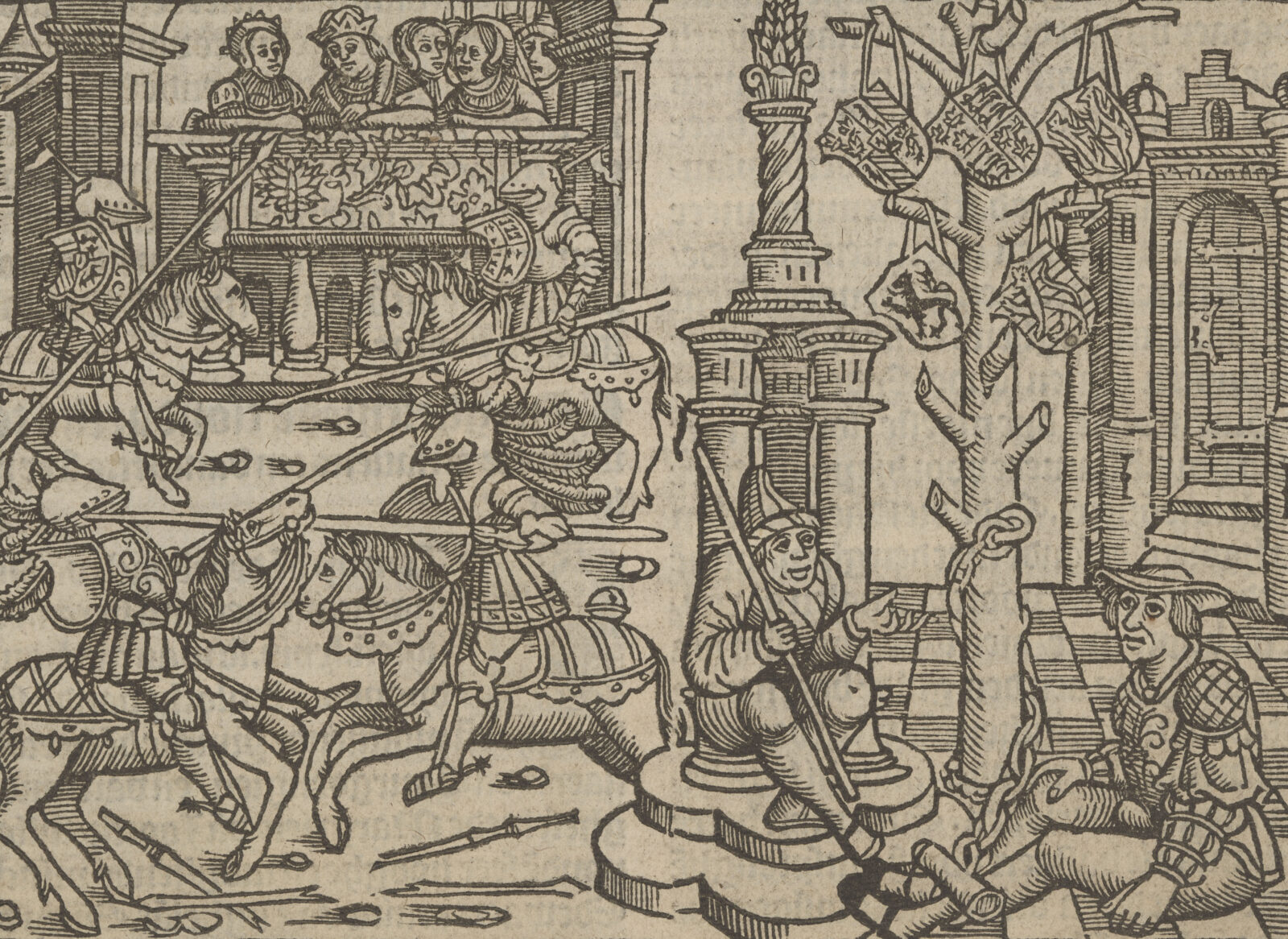Zowat alles kwam terecht op de tafels van het banket, behalve… vorken. Die heb je ook niet nodig met een snijder in de buurt. Restjes gooi je op de grond, eten doe je met je vingers. Dop ze alleen niet dieper in de sauskom dan je eerste vingerkootjes – dat is niet fatsoenlijk. Als ‘borden’ werden handgebakken broodkorsten gebruikt. Etensresten, inclusief de broden, werden aan de armen geschonken. Drinken deed men vaak met meerderen uit een beker. Maar verder liep alles vrij beschaafd, zeker in de hogere kringen. Schrokken en met volle mond praten was uit den boze. Je neus snuiten in een servet was not done. Overgeven was dan weer geen schande, al moest dat bij voorkeur een beetje afgelegen gebeuren. En wie een wind moest laten, werd aangeraden om het geluid door hoesten te verhullen.

Chapter 3: The wedding celebrations
Enough about the past, let’s party! The crème de la crème of society eagerly waits the start of the wedding banquet at the Prinsenhof. The Burgundians are known for their extravagance, and this wedding will go down in history as one of the most impressive weddings ever. The smell of delicious pasties and roasts fills the streets. Exotic animals are everywhere you look: a unicorn, a leopard, or even a whale! There are even mermaids and mermen. Could it be more exciting? Then there are the knightly tournaments, culminating in the Passage of Arms of the Golden Tree. If you listen carefully, you can still hear the echoes of the celebration in the streets of Bruges even after 566 years…
The invitees The banquet Passage of the Arms of the Golden Tree The story of the Golden Tree
The invitees
No one wants to miss the celebration of the century. All the notable figures of the city, the Bruges municipalities, and the Franc of Bruges, as well as the commoners, celebrate with them. The foreign merchants, united into nations, accompanied Margaret at the entry. The Catalan nation is the oldest; that of the Germans or Easterners is the largest. The nations first met in monasteries, but later established their own nation houses. For instance, the Genoese live in the Genoese Lodge and the Venetians in Ter Beurse.
Knights of the Golden Fleece escort Margaret of York to her brand-new husband Charles the Bold in the Burgundian Prinsenhof. Immediately behind the bride rides Mary of Burgundy, Charles the Bold’s eleven-year-old daughter from his second marriage to Isabelle of Bourbon.
Het banket
“Je leeft maar één keer”, denken Karel de Stoute en Margaretha van York. Op hun huwelijksbanket worden hele ossen aan het spit geroosterd. Op het menu staan gebraden beren, zwanen, kraanvogels, snoeken, steuren, reebokken en konijnen. Er zijn pasteien, groot genoeg om er vuurspuwers, zangers of zwaardvechters een plaatsje in te geven – in levende lijve! Doe er nog zingende leeuwen en ezels bij, luit spelende everzwijnen en vuurspuwende draken, een griffioen die levende vogeltjes braakt, een kameel, een eenhoorn en een walvis. Je kunt het zo gek niet bedenken! Nu we toch bezig zijn: uit de bek van de walvis komen zingende meermannen en zeemeerminnen… En dat alles in een feestzaal waar het zelfs kon regenen, donderen en sneeuwen. Knettergek!

Passage of Arms of the Golden Tree
A major spectacle, the great tournament of the Golden Tree in 1468 was the highlight of Burgundian splendour. In honour of his brother’s wedding, Anthony, the Great Bastard of Burgundy, bastard son of Philip the Good and thus half-brother of Charles the Bold, organised the Passage of Arms of the Golden Tree.
A passage of arms is a knights’ tournament in a theatrical format where one knight competes against many. Only the very highest nobility enters the tournament in the most lavishly embroidered armour, crimson tunics, ermine coats… On the last day of the tournament, all the knights fly at each other, dressed in violet armour topped with an embroidered golden tree. Even Charles the Bold himself fights in this metal melee. This is highly unusual, although not surprising for Charles himself, as a braggart and fighter pur sang… Margaret is less enthusiastic and soon has the fight ended. English knight Anthony Woodville wins the tournament and John of Chalon, Lord of Arlay, wins a harnessed horse.
There can be no clash of arms without the Bruges military guilds. The St George’s Archers Guild of Bruges is one of the oldest in Belgium. The guild is mentioned as early as the 1320s. They were called up on whenever war raged, even up into the 14th century. The list of guild masters includes some famous names such as Anselm Adornes and Louis de Bruges, Lord of Gruuthuse. The Saint Sebastian Guild is the only association that dates back to the city of Bruges’s heyday and has continued to function continuously until today. The guild is represented in the Pageant by the Vrye Archiers van Mynheere Sint-Sebastiaen, whose founding charter was signed by Charles the Bold in 1476. St Michael’s Guild, Halberdiers, appears as an organised guild as early as 1444. In the Pageant, they perform feats of swordsmanship in a melee with Anthony of Burgundy, John IV of Chalon-Arlay, Anthony Woodville, Philippe de Crèvecœur d’Esquerdes, and Adolph of Cleves, Lord of Ravenstein. The culveriners or cannoneers were officially recognised in 1517. The aforementioned military guilds are still active in Bruges.

The story of the Golden Tree
What exactly is the story of the Golden Tree? There are several versions to be found. There are variants where the Bastard fights for the favours of a woman ruler, in which he must win his freedom, or where he just has to win the love of a princess. In any case, protagonist Anthony of Burgundy always starts out on an unknown island, and then ends up in the hands of a formidable beauty and a dwarf. A dwarf, by the way, who is so sneaky that he even keeps a giant as a servant! That giant is tied to a silver chain, which is attached to a Golden Tree. Anthony will never regain his freedom unless he manages to compete with every knight on the unknown island. “Break 101 lances. Whether you break them yourself or they are broken on you doesn’t matter. Deal or take 101 [some sources speak of 131] sword strokes. Finally, decorate the Golden Tree with the coats of arms of vanquished knights.” Depending on the version, Anthony thereby wins freedom, love, or the favours of the femme fatale Ere: beautiful but deadly! It is this vision, this dream, that Anthony, the Great Bastard of Burgundy, wanted to turn into reality in honour of the wedding. And he did! He plopped a massive golden tree on the Markt in Bruges with a note attached: “Let no one be surprised by this platform, it is a venture that awakens noble hearts, in memory of the so honoured Lady of Virtue and of the hidden island.”
